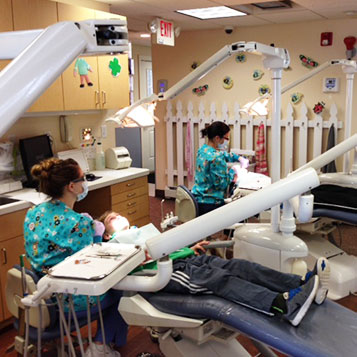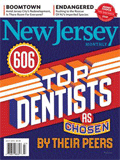Sedation & Anesthesia Options
Conscious Sedation
Nitrous Oxide
General Anesthesia
Conscious Sedation
Conscious sedation is recommended for apprehensive children, very young children, and children with special needs. It is used to calm your child and to reduce the anxiety or discomfort associated with dental treatments. Your child may be quite drowsy, and may even fall asleep, but they will not become unconscious.
There are a variety of different medications, which can be used for conscious sedation. The doctor will prescribe the medication best suited for your child’s overall health and dental treatment recommendations. We will be happy to answer any questions you might have concerning the specific drugs we plan to give to your child.
Prior to your appointment:
- Please notify us of any change in your child’s health and/or medical condition. Do not bring your child for treatment with a fever, ear infection or cold. Should your child become ill, contact us to see if it is necessary to postpone the appointment.
- You must tell the doctor of any drugs that your child is currently taking and any drug reactions and/or change in medical history.
- Please dress your child in loose fitting, comfortable clothing.
- Please make sure that your child goes to the bathroom immediately prior to arriving at the office.
- Your child should not have solid food for at least six hours prior to their sedation appointment and only clear liquids for up to four hours before the appointment.
- The child’s parent or legal guardian must remain at the office during the complete procedure.
- Please watch your child closely while the medication is taking effect. Hold them in your lap or keep close to you. Do not let them “run around.”
- Your child will act drowsy and may become slightly excited at first.
After the sedation appointment:
- Your child will be drowsy and will need to be monitored very closely. Keep your child away from areas of potential harm.
- If your child wants to sleep, place them on their side with their chin up. Wake your child every hour and encourage them to have something to drink in order to prevent dehydration. At first it is best to give your child sips of clear liquids to prevent nausea. The first meal should be light and easily digestible.
- If your child vomits, help them bend over and turn their head to the side to insure that they do not inhale the vomit.
- Because we use local anesthetic to numb your child’s mouth during the procedure, your child may have the tendency to bite or chew their lips, cheeks, and/or tongue and/or rub and scratch their face after treatment. Please observe your child carefully to prevent any injury to these areas.
- Please call our office for any questions or concerns that you might have.
FAQ
Q: What is conscious sedation?
A: Conscious sedation is a management technique that uses medications to assist the child to cope with fear and anxiety and cooperate with dental treatment.
Q: Why utilize conscious sedation?
A: Conscious sedation aids in allowing a child to cope better with dental treatment. This can help prevent injury to the child from patient movement and promote a better environment for providing dental care.
Q: What medications are used?
A: Many different medications can be used for conscious sedation. Your pediatric dentist will discuss different options for your child.
Q: Is sedation safe?
A: Sedation is safe when administered by a trained pediatric dentist who follows the sedation guidelines of the American Academy of Pediatric Dentistry. Your pediatric dentist will discuss sedation options and patient monitoring for the protection of your child.
Q: What special instructions should I follow before the sedation appointment?
A: In order to alleviate potential anxiety in your child, your pediatric dentist may recommend minimal discussion of the dental appointment with your child. Should your child become ill, contact your pediatric dentist to see if it is necessary to postpone the appointment. It is very important to follow the directions of your pediatric dentist regarding fasting from fluids and foods prior to the sedation appointment.
Q: What special instructions should I follow after the sedation appointment?
A: Your pediatric dentist will not discharge your child until the child is alert and ready to go. Children who have been sedated are requested to remain at home for the rest of the day with adult supervision. Your pediatric dentist will discuss specific post-sedation instructions with you, including appropriate diet, physical activity, and requested supervision
Nitrous Oxide
Some children are given nitrous oxide/oxygen, or what you may know as laughing gas, to relax them for their dental treatment. Nitrous oxide/oxygen is a blend of two gases, oxygen and nitrous oxide. Nitrous oxide/oxygen is given through a small breathing mask which is placed over the child’s nose, allowing them to relax, but without putting them to sleep. The American Academy of Pediatric Dentistry, recognizes this technique as a very safe, effective technique to use for treating children’s dental needs. The gas is mild, easily taken, then with normal breathing, it is quickly eliminated from the body. It is non-addictive. While inhaling nitrous oxide/oxygen, your child remains fully conscious and keeps all natural reflexes.
Prior to your appointment:
- Please inform us of any change to your child’s health and/or medical condition.
- Tell us about any respiratory condition that makes breathing through the nose difficult for your child. It may limit the effectiveness of the nitrous oxide/oxygen.
- Let us know if your child is taking any medication on the day of the appointment.
- Do not eat two to three hours prior.
General Anesthesia
General anesthesia is recommended for apprehensive children, very young children, and children with special needs that would not work well under conscious sedation or IV sedation. General anesthesia renders your child completely asleep. This would be the same as if he/she was having their tonsils removed, ear tubes, or hernia repaired. While the assumed risks are greater than that of other treatment options, if this is suggested for your child, the benefits of treatment this way have been deemed to outweigh the risks. The inherent risks if this is not chosen are multiple appointments, potential for physical restraint to complete treatment, and possible emotional and/or physical injury to your child in order to complete their dental treatment. The risks of NO treatment include tooth pain, infection, swelling, the spread of new decay, damage to their developing adult teeth, and possible life-threatening hospitalization from a dental infection.
Prior to your appointment:
- Please notify us of any change in your child’s health. Do not bring your child for treatment with a fever, ear infection, or cold. Should your child become ill, contact us to see if it is necessary to postpone the appointment.
- You must tell the doctor of any drugs that your child is currently taking and any drug reactions and/or change in medical history.
- Please dress your child in loose fitting, comfortable clothing.
- Your child should not have milk or solid food after midnight prior to the scheduled procedure. Clear liquids are allowed up to six hours prior to the appointment. ONLY water, apple juice, or Gatorade can be consumed.
- The child’s parent or legal guardian must remain in waiting room during the entire procedure.
After the appointment:
- Your child will be drowsy and will need to be monitored very closely. Keep your child away from areas of potential harm.
- If your child wants to sleep, place them on their side with their chin up. Wake your child every hour and encourage them to have something to drink in order to prevent dehydration. At first it is best to give your child sips of clear liquids to prevent nausea. The first meal should be light and easily digestible.
- If your child vomits, help them bend over and turn their head to the side to insure that they do not inhale the vomit.
- Prior to leaving the office, you will be given a detailed list of “Post-Op Instructions” and an emergency contact number if needed.






